Did Ghana Do Enough? A Scientometric Analysis of COVID-19 Research Output from Ghana within the African Context
Abstract
1. Introduction
2. Materials and Methods
2.1. Search Strategy for Most Productive Countries in Africa
2.2. Search Strategy for COVID-19 Data on Ghana
2.3. Search Strategy for Various Subject Areas Related to Ghana COVID-19 Research
2.4. Strategy for Obtaining Data on Citations
3. Results
3.1. Africa’s Most Productive Countries and Where Ghana Lies with Regards to COVID-19 Research Output
3.2. Ghana’s COVID-19 Research Output from 2019–2022: Published Document Types
3.3. International Collaborations in Ghana’s COVID-19 Publication Output from 2019–2022
3.4. Ghana’s Publication Output by Subject Area
3.5. Most Productive Ghanaian Institutions in COVID-19 Research from 2019–2022
3.6. Characteristics of the Most Productive Ghanaian Researchers on COVID-19 Research
3.7. Journals Publishing the Highest Number of Ghana’s COVID-19 Documents from 2019–2022
3.8. Characteristics of Highly-Cited Papers from 2019 to 2022
3.9. Top Funding Sources for Ghana’s COVID-19 Research Output from 2019–2022
4. Discussion
5. Conclusions
Author Contributions
Funding
Institutional Review Board Statement
Informed Consent Statement
Data Availability Statement
Conflicts of Interest
References
- Zhu, N.; Zhang, D.; Wang, W.; Li, X.; Yang, B.; Song, J.; Zhao, X.; Huang, B.; Shi, W.; Lu, R.; et al. A novel coronavirus from patients with pneumonia in China, 2019. N. Eng. J. Med. 2020, 8, 727–733. [Google Scholar] [CrossRef] [PubMed]
- Huang, C.; Wang, Y.; Li, X.; Ren, L.; Zhao, J.; Hu, Y.; Zhang, L.; Fan, G.; Xu, J.; Gu, X. Clinical features of patients infected with 2019 novel coronavirus in Wuhan, China. Lancet 2020, 395, 497–506. [Google Scholar] [CrossRef] [PubMed]
- Wu, F.; Zhao, S.; Yu, B.; Chen, Y.-M.; Wang, W.; Song, Z.-G.; Hu, Y.; Tao, Z.-W.; Tian, J.-H.; Pei, Y.-Y. A new coronavirus associated with human respiratory disease in China. Nature 2020, 579, 265–269. [Google Scholar] [CrossRef] [PubMed]
- Kronbichler, A.; Effenberger, M.; Eisenhut, M.; KH, L.; JI, S. Seven recommendations to rescue the patients and reduce the mortality from COVID-19 infection: An immunological point of view. Autoimmun. Rev. 2020, 19, 102570. [Google Scholar] [CrossRef] [PubMed]
- Ahmed, A.; Ali, A.; Hasan, S. Comparison of epidemiological variations in COVID-19 patients inside and outside of China—A meta-analysis. Front. Public Health 2020, 8, 193. [Google Scholar] [CrossRef]
- Mohammadi, M.; Meskini, M.; do Nascimento Pinto, A.L. 2019 Novel coronavirus (COVID-19) overview. Z. Gesundh. Wiss. 2022, 30, 167–175. [Google Scholar] [CrossRef]
- Mullol, J.; Alobid, I.; Mariño-Sánchez, F.; Izquierdo-Domínguez, A.; Marin, C.; Klimek, L.; Wang, D.-Y.; Liu, Z. The loss of smell and taste in the COVID-19 outbreak: A tale of many countries. Curr. Allergy Asthma Rep. 2020, 20, 1–5. [Google Scholar] [CrossRef]
- Worldometer. Available online: https://www.worldometers.info/coronavirus/ (accessed on 30 December 2022).
- GHS: COVID-19 Vaccines Doses Administered: 13 January 2023. 2023. Available online: https://ghs.gov.gh/covid19/ (accessed on 4 January 2023).
- Aduhene, D.T.; Osei-Assibey, E. Socio-economic impact of COVID-19 on Ghana’s economy: Challenges and prospects. Int. J. Soc. Econ. 2021, 48, 543–556. [Google Scholar] [CrossRef]
- Agyekum, M.W.; Afrifa-Anane, G.F.; Kyei-Arthur, F.; Addo, B. Acceptability of COVID-19 vaccination among health care workers in Ghana. Adv. Public Health 2021, 2021, 1–8. [Google Scholar] [CrossRef]
- Adom, D.; Mensah, J.A.; Osei, M. The psychological distress and mental health disorders from COVID-19 stigmatization in Ghana. Soc. Sci. Humanit. Open 2021, 4, 100186. [Google Scholar] [CrossRef]
- Agyemang-Duah, W.; Morgan, A.K.; Oduro Appiah, J.; Peprah, P.; Fordjour, A.A. Re-integrating older adults who have recovered from the novel coronavirus into society in the context of stigmatization: Lessons for health and social actors in Ghana. J. Gerontol. Soc. Work 2020, 63, 691–693. [Google Scholar] [CrossRef] [PubMed]
- Song, P.; Karako, T. COVID-19: Real-time dissemination of scientific information to fight a public health emergency of international concern. Biosci. Trends 2020, 14, 1–2. [Google Scholar] [CrossRef] [PubMed]
- Falagas, M.E.; Pitsouni, E.I.; Malietzis, G.A.; Pappas, G. Comparison of PubMed, Scopus, web of science, and Google scholar: Strengths and weaknesses. FASEB J. 2008, 22, 338–342. [Google Scholar] [CrossRef] [PubMed]
- Kana, M.A.; LaPorte, R.; Jaye, A. Africa’s contribution to the science of the COVID-19/SARS-CoV-2 pandemic. BMJ Glob. Health 2021, 6, e004059. [Google Scholar] [CrossRef] [PubMed]
- Yalley, A.K.; Ahiatrogah, S.; Kafintu-Kwashie, A.A.; Amegatcher, G.; Prah, D.; Botwe, A.K.; Adusei-Poku, M.A.; Obodai, E.; Nii-Trebi, N.I. A systematic review on suitability of molecular techniques for diagnosis and research into infectious diseases of concern in resource-limited settings. Curr. Issues Mol. Biol. 2022, 44, 4367–4385. [Google Scholar] [CrossRef] [PubMed]
- Blanton, R.E.; Mock, N.B.; Hiruy, H.N.; Schieffelin, J.S.; Doumbia, S.; Happi, C.; Samuels, R.J.; Oberhelman, R.A. African resources and the promise of resilience against COVID-19. Am. J. Trop. Med. Hyg. 2020, 103, 539. [Google Scholar] [CrossRef]
- Kapata, N.; Ihekweazu, C.; Ntoumi, F.; Raji, T.; Chanda-Kapata, P.; Mwaba, P.; Mukonka, V.; Bates, M.; Tembo, J.; Corman, V. Is Africa prepared for tackling the COVID-19 (SARS-CoV-2) epidemic. Lessons from past outbreaks, ongoing pan-African public health efforts, and implications for the future. Int. J. Infect. Dis. 2020, 93, 233–236. [Google Scholar] [CrossRef]
- Azungah, T. Challenges in accessing research sites in Ghana: A research note. Qual. Res. Organ. Manag. Int. J. 2019, 14, 410–427. [Google Scholar] [CrossRef]
- Mensah, M.S.B.; Enu-Kwesi, F.; Boohene, R. Challenges of research collaboration in Ghana’s knowledge-based economy. J. Knowl. Econ. 2019, 10, 186–204. [Google Scholar] [CrossRef]
- Amewu, R.K.; Amoateng, P.; Arthur, P.K.; Asare, P.; Asiamah, I.; Boamah, D.; Darko Otchere, I.; Dzidzor Amengor, C.; Ekuadzi, E.; Chibale, K. Drug discovery research in Ghana, challenges, current efforts, and the way forward. PLoS Negl. Trop. Dis. 2022, 16, e0010645. [Google Scholar] [CrossRef]
- Appeaning, M.; Owusu-Asante, H.; Kwofie, S.; Arhin, G.; Asamoah, A.O.; Ali, T.; Amponsah, R.R. Improving community participation in clinical trials in Ghana; factors to consider. Contemp. Clin. Trials Commun. 2022, 30, 101012. [Google Scholar] [CrossRef] [PubMed]
- Leydesdorff, L.; Milojević, S. Scientometrics. arXiv 2012, arXiv:12084566. [Google Scholar]
- Burnham, J.F. Scopus database: A review. Biomed. Digit. Libr. 2006, 3, 1–8. [Google Scholar] [CrossRef] [PubMed]
- Schotten, M.; Meester, W.J.; Steiginga, S.; Ross, C.A. A brief history of Scopus: The world’s largest abstract and citation database of scientific literature. In Research Analytics; Auerbach Publications: Boca Raton, FL, USA, 2017; pp. 31–58. [Google Scholar]
- Borgohain, D.J. Research Output of Dibrugarh University: A Scientometric Analysis based on Scopus Database. Libr. Philos. Pract. E-J. 2020, 4827. [Google Scholar]
- Villar, J.; Ariff, S.; Gunier, R.B.; Thiruvengadam, R.; Rauch, S.; Kholin, A.; Roggero, P.; Prefumo, F.; Do Vale, M.S.; Cardona-Perez, J.A.; et al. Maternal and neonatal morbidity and mortality among pregnant women with and without COVID-19 infection: The INTERCOVID multinational cohort study. JAMA Pediatr. 2021, 175, 817–826. [Google Scholar] [CrossRef]
- Lamontagne, F.; Agoritsas, T.; Macdonald, H.; Leo, Y.-S.; Diaz, J.; Agarwal, A.; Appiah, J.A.; Arabi, Y.; Blumberg, L.; Calfee, C.S.; et al. A living WHO guideline on drugs for COVID-19. BMJ 2020, 370, m3379. [Google Scholar] [CrossRef]
- Ayittey, F.K.; Ayittey, M.K.; Chiwero, N.B.; Kamasah, J.S.; Dzuvor, C. Economic impacts of Wuhan 2019-nCoV on China and the world. J. Med. Virol. 2020, 92, 473. [Google Scholar] [CrossRef]
- Chakaya, J.; Khan, M.; Ntoumi, F.; Aklillu, E.; Fatima, R.; Mwaba, P.; Kapata, N.; Mfinanga, S.; Hasnain, S.E.; Katoto, P.D.; et al. Global Tuberculosis Report 2020–Reflections on the Global TB burden, treatment and prevention efforts. Int. J. Infect. Dis. 2021, 113, S7–S12. [Google Scholar] [CrossRef]
- Kontis, V.; Bennett, J.E.; Rashid, T.; Parks, R.M.; Pearson-Stuttard, J.; Guillot, M.; Asaria, P.; Zhou, B.; Battaglini, M.; Corsetti, G.; et al. Magnitude, demographics and dynamics of the effect of the first wave of the COVID-19 pandemic on all-cause mortality in 21 industrialized countries. Nat. Med. 2020, 26, 1919–1928. [Google Scholar] [CrossRef]
- Tabah, A.; Ramanan, M.; Laupland, K.B.; Buetti, N.; Cortegiani, A.; Mellinghoff, J.; Morris, A.C.; Camporota, L.; Zappella, N.; Elhadi, M.; et al. Personal protective equipment and intensive care unit healthcare worker safety in the COVID-19 era (PPE-SAFE): An international survey. J. Crit. Care 2020, 59, 70–75. [Google Scholar] [CrossRef]
- Zhou, B.; Perel, P.; Mensah, G.A.; Ezzati, M. Global epidemiology, health burden and effective interventions for elevated blood pressure and hypertension. Nat. Rev. Cardiol. 2021, 18, 785–802. [Google Scholar] [CrossRef] [PubMed]
- Kretchy, I.A.; Asiedu-Danso, M.; Kretchy, J.-P. Medication management and adherence during the COVID-19 pandemic: Perspectives and experiences from low-and middle-income countries. Res. Social Adm. Pharm. 2021, 17, 2023–2026. [Google Scholar] [CrossRef] [PubMed]
- Haider, N.; Osman, A.Y.; Gadzekpo, A.; Akipede, G.O.; Asogun, D.; Ansumana, R.; Lessells, R.J.; Khan, P.; Hamid, M.M.A.; Yeboah-Manu, D.; et al. Lockdown measures in response to COVID-19 in nine sub-Saharan African countries. BMJ Glob. Health 2020, 5, e003319. [Google Scholar] [CrossRef] [PubMed]
- Paulson, K.R.; Kamath, A.M.; Alam, T.; Bienhoff, K.; Abady, G.G.; Abbas, J.; Abbasi-Kangevari, M.; Abbastabar, H.; Abd-Allah, F.; Abd-Elsalam, S.M.; et al. Global, regional, and national progress towards Sustainable Development Goal 3.2 for neonatal and child health: All-cause and cause-specific mortality findings from the Global Burden of Disease Study 2019. Lancet 2021, 398, 870–905. [Google Scholar] [CrossRef] [PubMed]
- Asamoah, J.K.K.; Owusu, M.A.; Jin, Z.; Oduro, F.; Abidemi, A.; Gyasi, E.O. Global stability and cost-effectiveness analysis of COVID-19 considering the impact of the environment: Using data from Ghana. Chaos Solitons Fractals 2020, 140, 110103. [Google Scholar] [CrossRef]
- Sanchez-Felipe, L.; Vercruysse, T.; Sharma, S.; Ma, J.; Lemmens, V.; Van Looveren, D.; Arkalagud Javarappa, M.P.; Boudewijns, R.; Malengier-Devlies, B.; Liesenborghs, L.A.; et al. Single-dose live-attenuated YF17D-vectored SARS-CoV-2 vaccine candidate. Nature 2021, 590, 320–325. [Google Scholar] [CrossRef]
- Abena, P.M.; Decloedt, E.H.; Bottieau, E.; Suleman, F.; Adejumo, P.; Sam-Agudu, N.A.; Muyembe TamFum, J.-J.; Seydi, M.; Eholie, S.P.; Mills, E.J.; et al. Chloroquine and Hydroxychloroquine for the Prevention or Treatment of COVID-19 in Africa: Caution for Inappropriate Off-label Use in Healthcare Settings. Am. J. Trop. Med. Hyg. 2020, 1184–1188. [Google Scholar] [CrossRef]
- Petersen, E.; Ntoumi, F.; Hui, D.S.; Abubakar, A.; Kramer, L.D.; Obiero, C.; Tambyah, P.A.; Blumberg, L.; Yapi, R.; Al-Abri, S.; et al. Emergence of new SARS-CoV-2 Variant of Concern Omicron (B. 1.1. 529)-highlights Africa’s research capabilities, but exposes major knowledge gaps, inequities of vaccine distribution, inadequacies in global COVID-19 response and control efforts. Int. J. Infect. Dis. 2022, 114, 268–272. [Google Scholar] [CrossRef]
- Dzisi, E.K.J.; Dei, O.A. Adherence to social distancing and wearing of masks within public transportation during the COVID 19 pandemic. Transp. Res. Interdiscip. Perspect. 2020, 7, 100191. [Google Scholar]
- Edem, B.; Williams, V.; Onwuchekwa, C.; Umesi, A.; Calnan, M. COVID-19-related research in Africa: A cross-sectional review of the International Clinical Trial Registration Platform (ICTRP). Trials 2021, 22, 1–8. [Google Scholar] [CrossRef]
- WHO. Available online: https://covid19.who.int/ (accessed on 8 January 2023).
- Tijssen, R. Africa’s contribution to the worldwide research literature: New analytical perspectives, trends, and performance indicators. Scientometrics 2007, 71, 303–327. [Google Scholar] [CrossRef]
- Uthman, O.A.; Wiysonge, C.S.; Ota, M.O.; Nicol, M.; Hussey, G.D.; Ndumbe, P.M.; Mayosi, B.M. Increasing the value of health research in the WHO African Region beyond 2015—Reflecting on the past, celebrating the present and building the future: A bibliometric analysis. BMJ Open 2015, 5, e006340. [Google Scholar] [CrossRef]
- Zyoud, S.e.H.; Al-Jabi, S.W. Mapping the situation of research on coronavirus disease-19 (COVID-19): A preliminary bibliometric analysis during the early stage of the outbreak. BMC Infect. Dis. 2020, 20, 1–8. [Google Scholar] [CrossRef] [PubMed]
- IMF. Available online: https://www.imf.org/en/Countries (accessed on 8 January 2023).
- Morang’a, C.M.; Ngoi, J.M.; Gyamfi, J.; Amuzu, D.S.; Nuertey, B.D.; Soglo, P.M.; Appiah, V.; Asante, I.A.; Owusu-Oduro, P.; Armoo, S. Genetic diversity of SARS-CoV-2 infections in Ghana from 2020-2021. Nat. Commun. 2022, 13, 1–11. [Google Scholar] [CrossRef] [PubMed]
- Mbogning Fonkou, M.D.; Bragazzi, N.L.; Tsinda, E.K.; Bouba, Y.; Mmbando, G.S.; Kong, J.D. COVID-19 pandemic related research in Africa: Bibliometric analysis of scholarly output, collaborations and scientific leadership. Int. J. Environ. Res. Public Health 2021, 18, 7273. [Google Scholar] [CrossRef]
- Hosseinzadeh, P.; Zareipour, M.; Baljani, E.; Moradali, M.R. Social Consequences of the COVID-19 Pandemic. A Systematic Review. Investig. Y. Educ. Enfermería 2022, 40, 10. [Google Scholar] [CrossRef]
- Boateng, F.K. Unfettering the ball and chain of gender discrimination: Gendered experiences of senior STEM women in Ghana. Cogent Educ. 2017, 4, 1418135. [Google Scholar] [CrossRef]
- Yalley, A.A.; Olutayo, M.S.; Adebayo, A.V. Martyrs of Socialisation: Understanding the Causes of Domestic Violence Through Women’s Narratives in Ghana and Nigeria. Gend. Behav. 2021, 19, 18487–18494. [Google Scholar]
- Yalley, A.A.; Abioye, D.; Appiah, S.C.Y.; Hoeffler, A. Abuse and humiliation in the delivery room: Prevalence and associated factors of obstetric violence in Ghana. Front. Public Health 2023, 11, 988961. [Google Scholar] [CrossRef]
- Sambunjak, D.; Huić, M.; Hren, D.; Katić, M.; Marušić, A.; Marušić, M. National vs. international journals: Views of medical professionals in Croatia. Learn. Publ. 2009, 22, 57–70. [Google Scholar] [CrossRef]
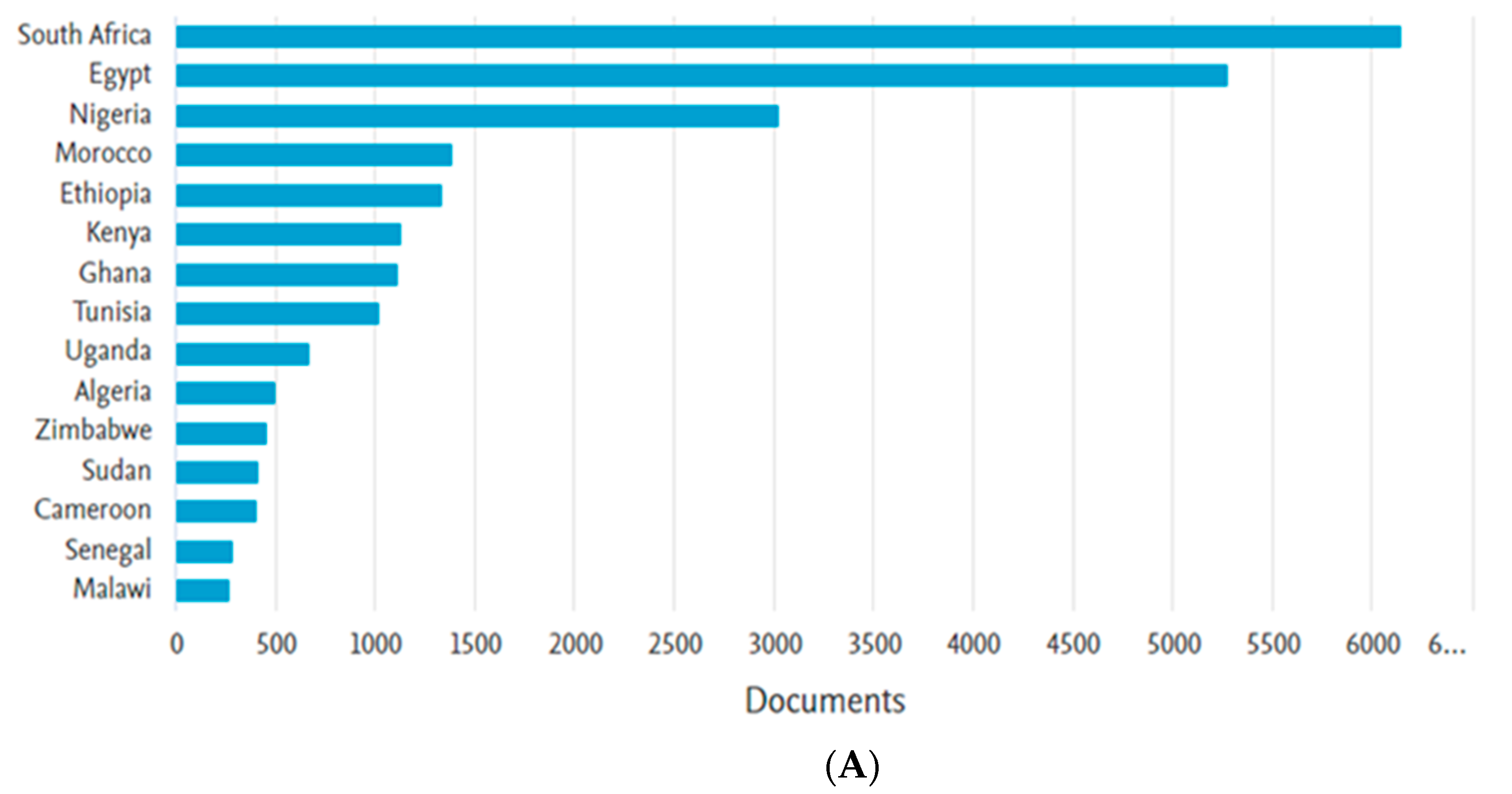
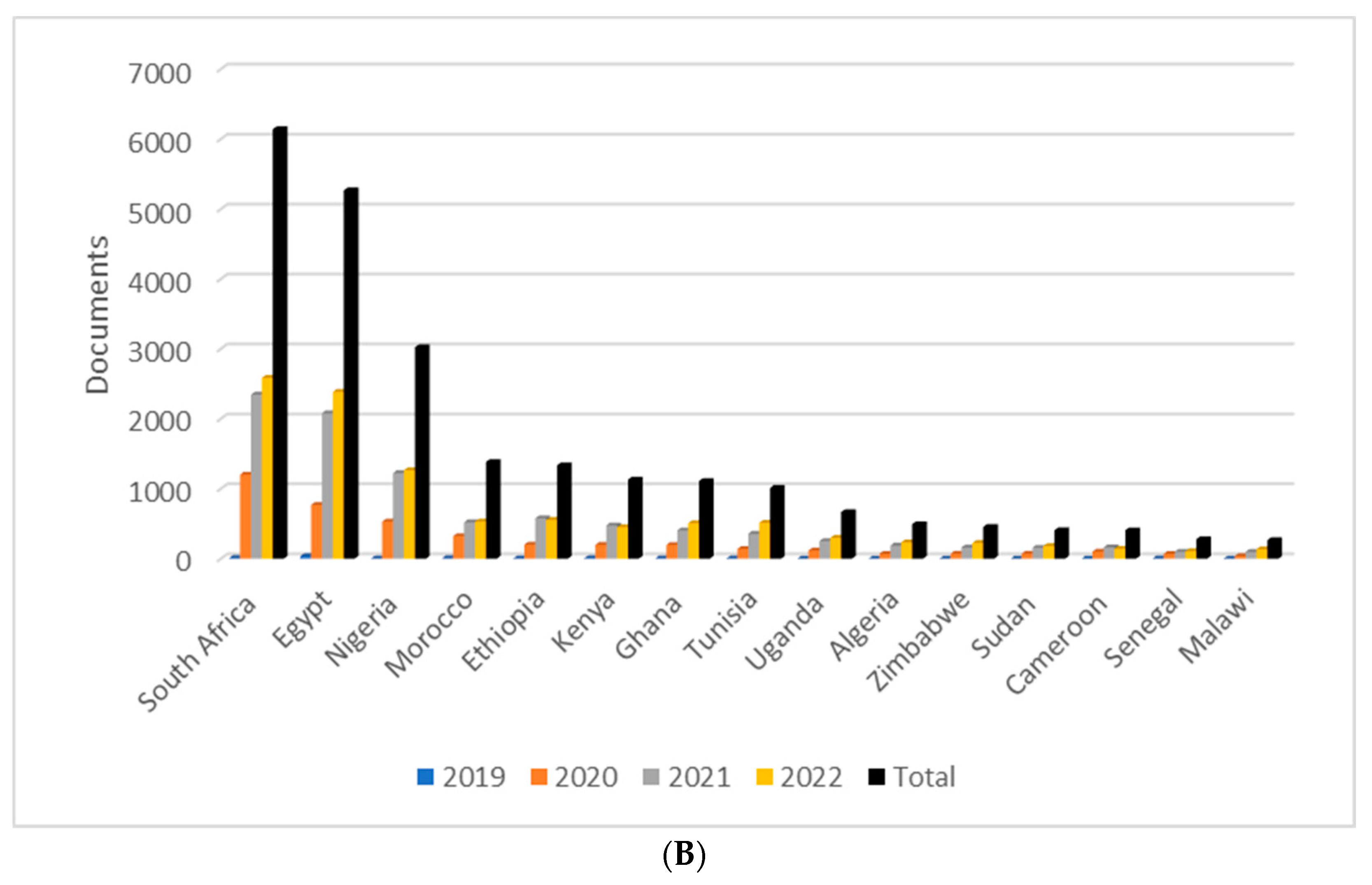
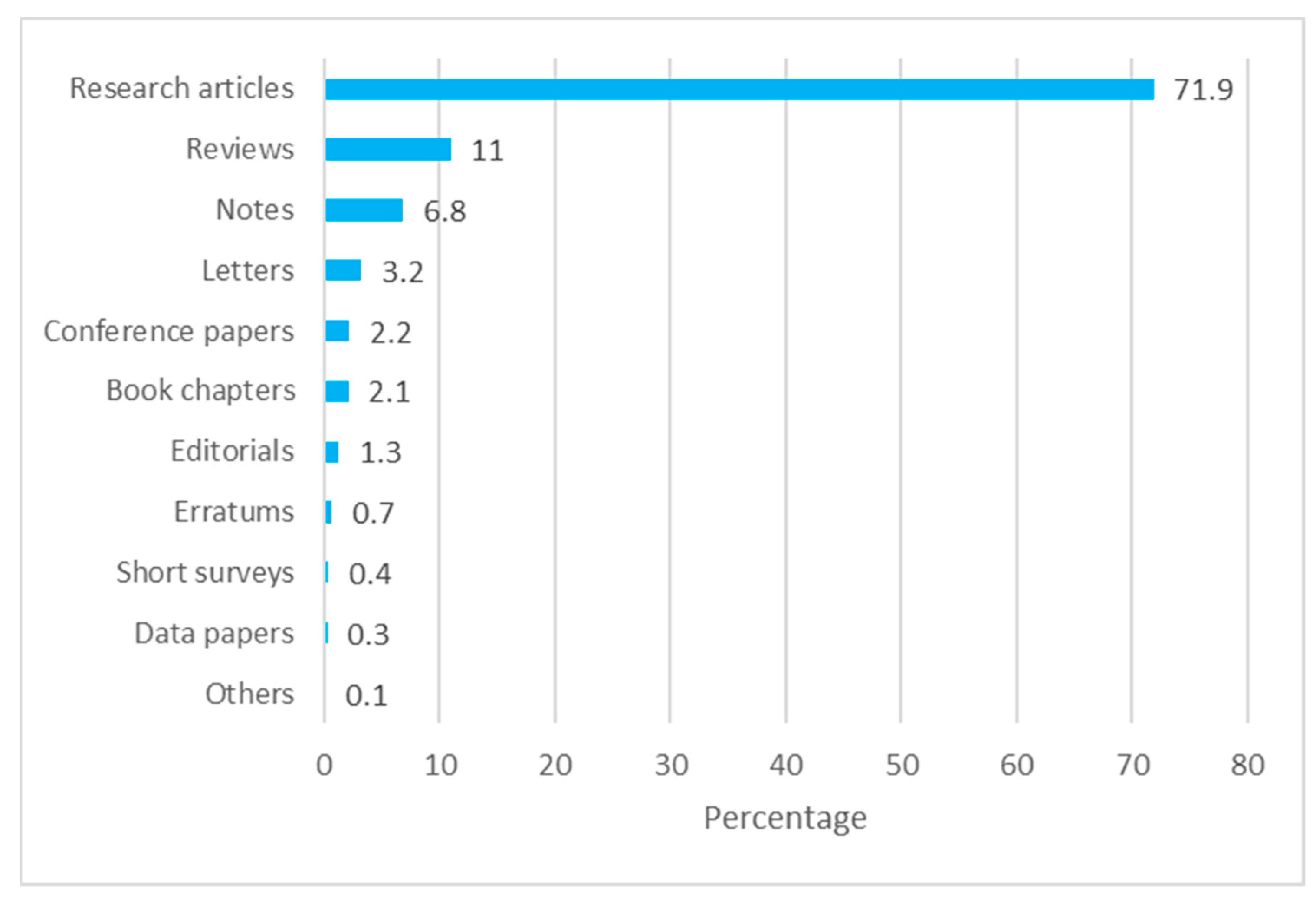

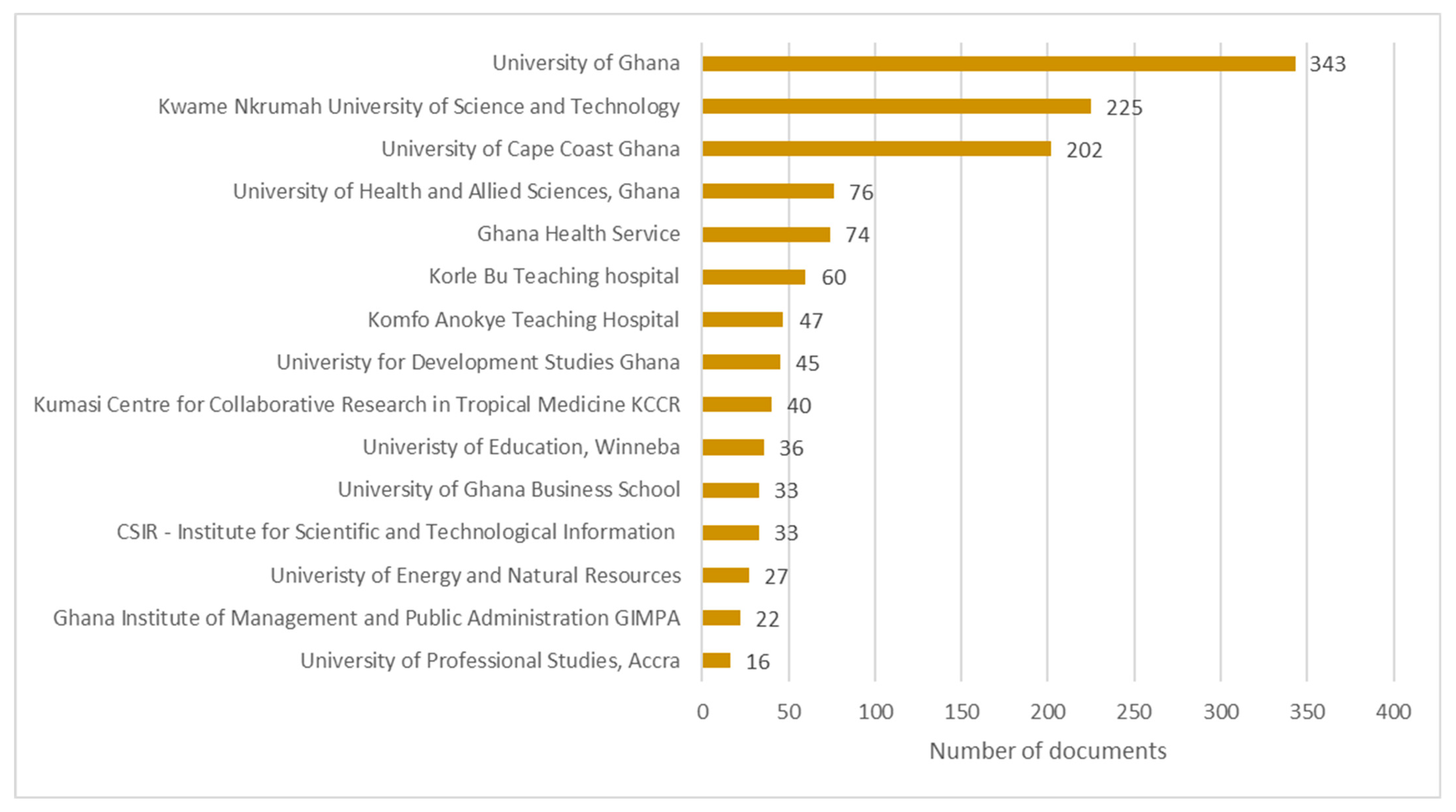
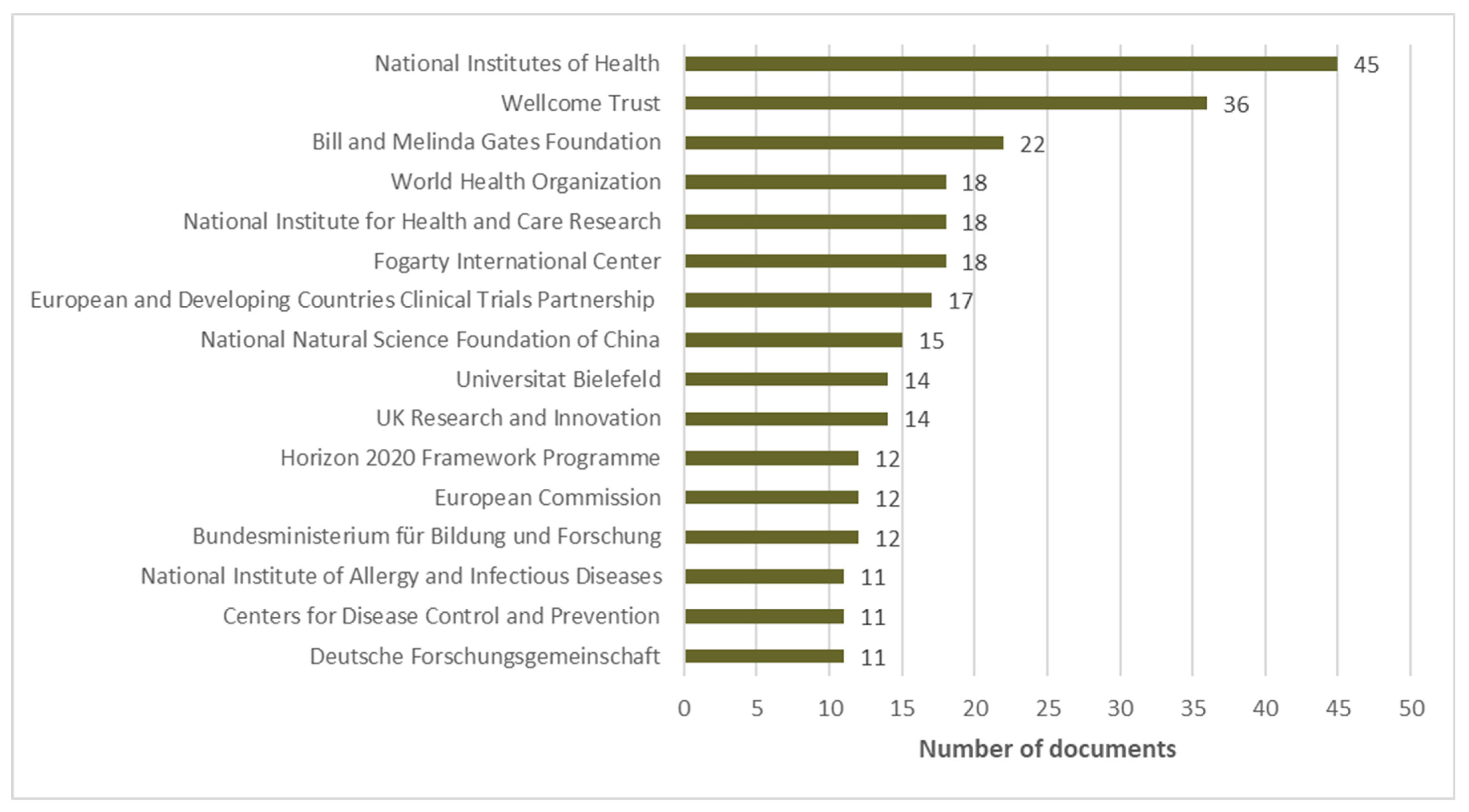
| Rank | Countries | Number of Joint Publications (%) |
|---|---|---|
| 1st | United States | 296 (26.6%) |
| 2nd | United Kingdom | 279 (25.1%) |
| 3rd | South Africa | 194 (17.5%) |
| 4th | Nigeria | 174 (15.7%) |
| 5th | Germany | 117 (10.5%) |
| 6th | Australia | 113 (10.2%) |
| 7th | India | 110 (9.9%) |
| 8th | Canada | 106 (9.5%) |
| 9th | Kenya | 92 (8.3%) |
| 10th | China | 89 (8.0%) |
| 11th | Switzerland | 73 (6.6%) |
| 12th | Brazil | 70 (6.3%) |
| 13th | Pakistan | 58 (5.2%) |
| 14th | Cameroon | 53 (4.8%) |
| 14th | Italy | 53 (4.8%) |
| 14th | Malaysia | 53 (4.8%) |
| Rank | Author | Sex | Affiliation | No. of Pub. |
|---|---|---|---|---|
| 1st | Amuasi, J. H. | Male | Kwame Nkrumah University of Science and Technology, Kumasi, Ghana | 20 |
| 2nd | Hagan, J. E. | Male | University of Cape Coast, Cape Coast, Ghana | 19 |
| 2nd | Owusu, M. | Male | Kwame Nkrumah University of Science and Technology, Kumasi, Ghana | 19 |
| 3rd | Sam-Agudu, N. A. | Female | University of Cape Coast, Cape Coast, Ghana | 18 |
| 4 th | Ahinkorah, B. O. | Male | University of Technology, Sidney, Australia | 15 |
| 5 th | Adam, A. M. | Male | University of Cape Coast, Cape Coast, Ghana | 13 |
| 5 th | Ameyaw, E. K. | Male | Lingnan University, Hong Kong, Hong Kong, | 13 |
| 5 th | Ayanore, M. A. | Male | University of Health and Allied Sciences, Ho, Ghana | 13 |
| 5 th | Seidu, A. A. | Male | University of Cape Coast, Cape Coast, Ghana | 13 |
| 6 th | Asafo-Adjei, E. | Male | University of Cape Coast, Cape Coast, Ghana | 11 |
| 6th | Phillips, R. O. | Male | Kwame Nkrumah University of Science and Technology, Kumasi, Ghana | 11 |
| 6th | Vanderpuye, V. | Female | Korle Bu Teaching Hospital, Accra, Ghana | 11 |
| 7th | Abu, E. K. | Male | University of Cape Coast, Cape Coast, Ghana | 10 |
| 7th | Adu-Sarkodie, Y. | Male | Kwame Nkrumah University of Science and Technology, Kumasi, Ghana | 10 |
| 7th | El-Duah, P. | Male | Charité—Universitätsmedizin Berlin | 10 |
| 7th | Kenu, E. | Male | University of Ghana, Accra, Ghana | 10 |
| 7th | Owusu Junior, P. | Male | University of Cape Coast, Cape Coast, Ghana | 10 |
| 7th | Quansah, Frank | Male | University of Education, Winneba, Ghana | 10 |
| 7th | Marcarious M. T. | Male | Tehran University of Medical Science/University of Ghana | 10 |
| 7th | Yeboah R. | Male | Kumasi Centre for Collaborative Research in Tropical Medicine (KCCR), Kumasi, Ghana | 10 |
| 7th | Yeboah-Manu, D. | Female | University of Ghana, Accra, Ghana | 10 |
| Rank | Journal | No. of Publications | Journal Characteristics |
|---|---|---|---|
| 1st | Plos One | 41 | Open access |
| 2nd | Ghana Medical Journal | 36 | Open access |
| 2nd | Pan African Medical Journal | 36 | Open access |
| 3rd | Frontiers In Public Health | 18 | Open access |
| 4th | International Journal of Environmental Research And Public Health | 17 | Open access |
| 5th | BMJ Global Health | 14 | Open access |
| 5th | Lancet | 14 | Hybrid |
| 6th | Scientific African | 11 | Open access |
| 7th | Heliyon | 10 | Open access |
| 7th | International Journal Of Infectious Diseases | 10 | Open access |
| 7th | Lancet Global Health | 10 | Open access |
| 8th | BMC Public Health | 9 | Open access |
| 9th | BMJ Open | 8 | Open access |
| 9th | Complexity | 8 | Open access |
| 9th | Nature Medicine | 8 | Hybrid |
| Rank | Authors | Document Title | Journal Title/Subject Area of Journal | Citation | Publication Type |
|---|---|---|---|---|---|
| 1st | Villar et al., 2021 [28] | Maternal and Neonatal Morbidity and Mortality among Pregnant Women with and without COVID-19 Infection: The INTERCOVID Multinational Cohort Study | JAMA Pediatrics/Medicine | 421 | Research article |
| 2nd | Lamontagne et al., 2020 [29] | A living WHO guideline on drugs for COVID-19 | The BMJ/Medicine | 416 | Research article |
| 3rd | Ayittey et al., 2020 [30] | Economic impacts of Wuhan 2019-nCoV on China and the world | Journal of Medical Virology/Medicine; Immunology and Microbiology | 236 | Note |
| 4th | Chakaya et al., 2021 [31] | Global Tuberculosis Report 2020—Reflections on the Global TB burden, treatment and prevention efforts | International Journal of Infectious Diseases/Medicine | 216 | Research article |
| 5th | Kontis et al., 2020 [32] | Magnitude, demographics and dynamics of the effect of the first wave of the COVID-19 pandemic on all-cause mortality in 21 industrialized countries | Nature Medicine/Biochemistry, Genetics and Molecular Biology | 189 | Research article |
| 6th | Tabah et al., 2020 [33] | Personal protective equipment and intensive care unit healthcare worker safety in the COVID-19 era (PPE-SAFE): An international survey | Journal of Critical Care/Medicine | 137 | Research article |
| 7th | Zhou et al., 2021 [34] | Global epidemiology, health burden and effective interventions for elevated blood pressure and hypertension | Nature Reviews Cardiology/Medicine | 135 | Review |
| 8th | Kretchy et al., 2021 [35] | Medication management and adherence during the COVID-19 pandemic: Perspectives and experiences from low-and middle-income countries | Research in Social and Administrative Pharmacy/Health Professions; Pharmacology, Toxicology and Pharmaceutics | 113 | Research article |
| 9th | Haider et al., 2020 [36] | Lockdown measures in response to COVID-19 in nine sub-Saharan African countries | BMJ Global Health/ Medicine | 109 | Review |
| 10th | Paulson et al., 2021 [37] | Global, regional, and national progress towards Sustainable Development Goal 3.2 for neonatal and child health: all-cause and cause-specific mortality findings from the Global Burden of Disease Study 2019 | The Lancet/Medicine | 94 | Research article |
| 10th | Asamoah et al., 2020 [38] | Global stability and cost-effectiveness analysis of COVID-19 considering the impact of the environment: using data from Ghana | Chaos, Solitons and Fractals/Mathematics; Physics and Astronomy | 94 | Research article |
| 10th | Sanchez-Felipe et al., 2021 [39] | A single-dose live-attenuated YF17D-vectored SARS-CoV-2 vaccine candidate | Nature/Multidisciplinary | 94 | Research article |
| 11th | Abena et al., 2020 [40] | Chloroquine and hydroxychloroquine for the prevention or treatment of COVID-19 in Africa: Caution for inappropriate off-label use in healthcare settings | American Journal of Tropical Medicine and Hygiene/Medicine; Immunology and Microbiology | 90 | Review |
| 12th | Petersen et al., 2022 [41] | Emergence of new SARS-CoV-2 Variant of Concern Omicron (B.1.1.529)—highlights Africa’s research capabilities, but exposes major knowledge gaps, inequities of vaccine distribution, inadequacies in global COVID-19 response and control efforts | International Journal of Infectious Diseases/Medicine | 86 | Editorial |
| 13th | Dzisi et al., 2020 [42] | Adherence to social distancing and wearing of masks within public transportation during the COVID 19 pandemic | Transportation Research Interdisciplinary Perspectives/Social Sciences; Decision Sciences; Environmental Science | 84 | Research article |
Disclaimer/Publisher’s Note: The statements, opinions and data contained in all publications are solely those of the individual author(s) and contributor(s) and not of MDPI and/or the editor(s). MDPI and/or the editor(s) disclaim responsibility for any injury to people or property resulting from any ideas, methods, instructions or products referred to in the content. |
© 2023 by the authors. Licensee MDPI, Basel, Switzerland. This article is an open access article distributed under the terms and conditions of the Creative Commons Attribution (CC BY) license (https://creativecommons.org/licenses/by/4.0/).
Share and Cite
Yalley, A.K.; Ahiatrogah, S.; Yalley, A.B.; Yankson, I.K.; Nii-Trebi, N.I.; Yalley, A.A. Did Ghana Do Enough? A Scientometric Analysis of COVID-19 Research Output from Ghana within the African Context. Diseases 2023, 11, 56. https://doi.org/10.3390/diseases11020056
Yalley AK, Ahiatrogah S, Yalley AB, Yankson IK, Nii-Trebi NI, Yalley AA. Did Ghana Do Enough? A Scientometric Analysis of COVID-19 Research Output from Ghana within the African Context. Diseases. 2023; 11(2):56. https://doi.org/10.3390/diseases11020056
Chicago/Turabian StyleYalley, Akua K., Selasie Ahiatrogah, Akuba B. Yalley, Isaac K. Yankson, Nicholas I. Nii-Trebi, and Abena Asefuaba Yalley. 2023. "Did Ghana Do Enough? A Scientometric Analysis of COVID-19 Research Output from Ghana within the African Context" Diseases 11, no. 2: 56. https://doi.org/10.3390/diseases11020056
APA StyleYalley, A. K., Ahiatrogah, S., Yalley, A. B., Yankson, I. K., Nii-Trebi, N. I., & Yalley, A. A. (2023). Did Ghana Do Enough? A Scientometric Analysis of COVID-19 Research Output from Ghana within the African Context. Diseases, 11(2), 56. https://doi.org/10.3390/diseases11020056






